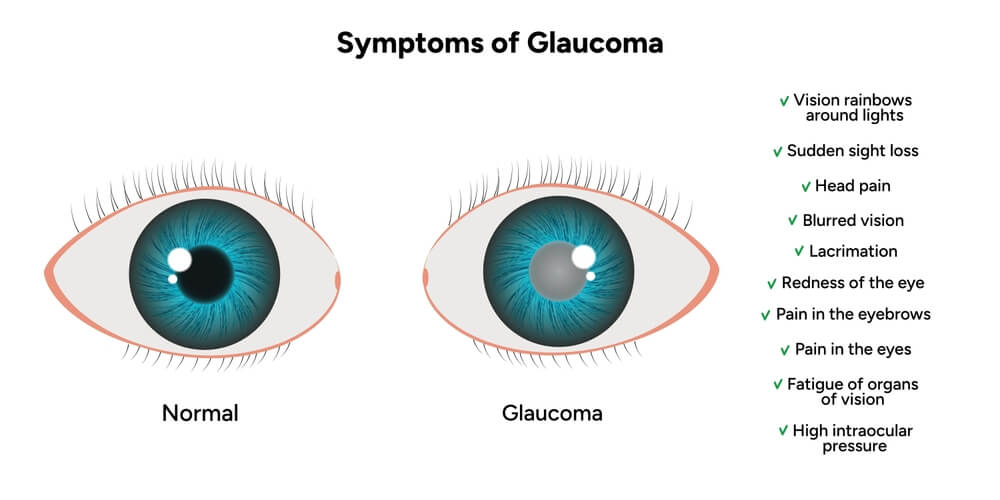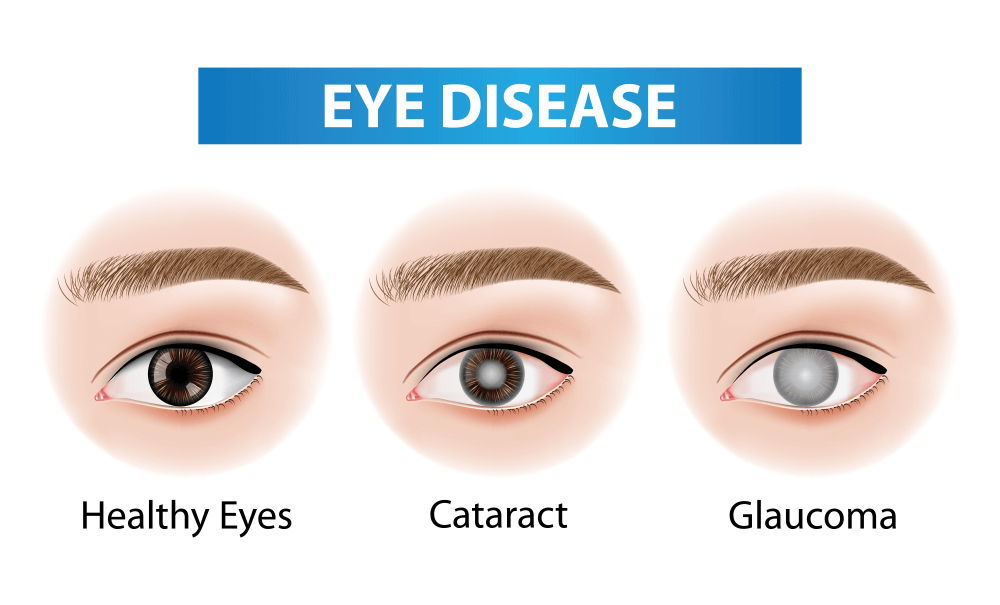Common eye disorders that can cause blindness include glaucoma and cataracts. Both may occur with age and trigger visual loss, therefore they are frequently misunderstood. But they are not the same. Glaucoma symptoms cause visual nerve damage owing to increased pressure in the eye, whereas cataracts cloud the lens.
This post will describe the primary distinctions between them. It will define each condition and explain the symptoms, causes, and treatment choices. Knowing these differences is critical for preserving eye health and avoiding vision loss. Early detection and therapy can help control both disorders more effectively. Regular eye exams are necessary to check your eye health.
What Is Glaucoma?

Optic nerve damage is a symptom of glaucoma. This nerve links the eye and brain. Glaucoma primarily affects older persons, particularly those aged 70 and up, however, it can occur at any age. Fluid accumulation in the front part of the eye is typically the source of the disorder. Glaucoma may also persist in families. People who have a parent or sibling with glaucoma have more chances to develop the disease themselves. Early detection of Glaucoma can be identified through routine eye exams.
There are several kinds of glaucoma, such as:
• Primary open angle glaucoma: This is the most typical kind, which comes on by a blockage in the drainage pathways of your eyes and grows progressively
• Congenital glaucoma, also known as childhood glaucoma, is a rare type of glaucoma that affects young children because of abnormality.
• Secondary glaucoma: This type develops by an underlying condition such as uveitis, diabetes, surgery, steroids, etc.
• Congenital glaucoma: also referred to as childhood glaucoma, this rare type grows by an abnormality in young children.
What Is A Cataract?

One common condition that affects eyesight is cataracts. These are areas of cloudiness that grow on your eye’s lens. Blurred or hazy vision occurs in cataracts, which usually affect older adults. They grow as protein clumps start growing on the lens and get larger over time.
A person may get one or both cataracts, but they are limited to one cataract in each eye.
Signs Of Glaucoma And Cataracts
Glaucoma may not show symptoms in its early stages. However, it may lead to symptoms that resemble cataracts, such as blurred vision and halos around lights. Open-angle glaucoma can produce blind patches on the sides of your eyes. This condition develops slowly, and you may lose up to 80-90% of your eyesight before becoming mindful of the problem. Although this vision loss is irreversible, early detection can help avoid it.
Closed-angle glaucoma can result in significant eye pain, nausea, headaches, and eye redness. Halos around nighttime lights are also common. Many individuals do not exhibit symptoms until they undergo a normal eye checkup.
If not addressed, these disorders can cause severe visual loss. Regular vision tests are essential for early detection and efficient management of the eye condition. Understanding the differences between glaucoma and cataracts can allow you to find the appropriate therapy and protect your vision.
How Are Glaucoma And Cataracts Different?
How glaucoma and cataracts impact the eye is one of their main distinctions. There are two distinct parts of the eye affected by the two disorders. A fluid accumulation in the eye leads to glaucoma, which affects eye pressure and damages the optic nerve in the rear of the eye. Protein that grows on the lens in the front portion of the eye causes cataracts.

Another important distinction is that patients with glaucoma symptoms cannot restore their glaucoma-related visual loss, whereas cataract sufferers may. Whereas cataract treatment is surgery, glaucoma typically requires treatment with prescribed eye drops, laser surgery, or microsurgical procedures such as trabeculectomy.
What Is The First Sign Of Cataracts?
The protein that makes up your lens may start to clump as you age. When cataracts first show symptoms, they can include:
- Feeling like your vision is foggy or fuzzy;
- Colours seem dimmer or faded;
- Increased glare from lamps, headlights, and the sun;
- Difficulty seeing at night;
- Increased need for frequent vision prescription adjustments;
- Double or triple vision in one eye
Can Cataracts Come Back?
There is currently no known cure for cataracts, and as people age, cataract development may become unavoidable. Some risk factors associated with lifestyle choices can raise your risk of cataract development. Among them are:
• Alcohol: Excessive alcohol intake can result in the production of free radicals, which can cause lens protein aggregation.
• Smoking: Smokers have an increased risk of cataract development.
• Obesity: Being overweight can release the hormone leptin, which can lead to oxidative stress and eye damage.
• Nutritional deficiency: Low levels of carotenoids, vitamin C, and vitamin E may increase the risk of cataract development.
By choosing healthier lifestyle choices, such as quitting smoking, drinking less alcohol, and maintaining a balanced diet, you can reduce your chance of cataract development.
What Is Usually The First Sign Of Glaucoma?
The initial sign of glaucoma is usually visual loss, particularly in the peripheral vision. This is also known as side or tunnel vision. If you notice any issues on the margins of your visual field, contact an eye specialist immediately.
Loss of vision typically indicates that glaucoma has progressed to an advanced stage, making treatment more difficult. Most people do not experience early warning signals until it is too late. This is particularly true for open-angle glaucoma, which is the most common kind.
That is why periodic checkups are so vital. Your eye doctor can use specialized technology to detect glaucoma symptoms early. Early identification can lead to improved options for treatment and help you keep your vision. Make eye checkups as part of your routine, rather than waiting for symptoms to arise. Proper care of the eyes is critical to preserving clear eyesight throughout your life.
Final Words
Glaucoma and cataracts can both result in visual loss if not detected and treated early. They can cause blurred vision, among other symptoms.
Glaucoma symptoms develops when fluid accumulates in the eye, increasing pressure on the optic nerve. If not controlled properly, this pressure might cause permanent visual loss. Treatment focuses on lowering the fluid pressure.
Cataracts arise when protein builds up in the eye lens, resulting in blurry vision, blurred vision, and impaired night vision. The chance of having cataracts increases with age. Luckily, most people can have their vision restored through cataract surgery.
Routine eye exams are essential for early diagnosis of these disorders. This helps maintain your healthy and clean eyes, especially as you age. Avoid waiting for symptoms and prioritize eye exams to safeguard your vision. Early intervention can significantly improve the management of certain eye disorders.


